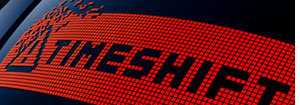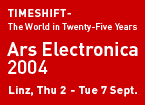 |
 |
 |
 |
 |
 |
Ars Electronica Highlights (September, 3)
The highpoint of the next day’s activities is the Ars Electronica Gala—the official opening of the Festival and the presentation of the 2004 Golden Nicas to the Prix Ars Electronica winners.
This will be the first time that the festival’s opening ceremony and the Prix Ars Electronica awards ceremony are being consolidated into a single gala event. Following the festivities kicking off this year’s festival, the winners of the 2004 Prix Ars Electronica will receive their Golden Nica statuettes.
At 9:30 PM, the scene shifts from the Brucknerhaus to the area surrounding the Ars Electronica Center. “Vita Pulsante” will feature fascinating projections, Japanese and local DJs will be manning the turntables in the Stadtwerkstatt, and the exhibitions in the Ars Electronica Center and the Ars Electronica Quarter will remain open for night owls. Then, it’s tee time in front of the Stadtwerkstatt as “FORE” opens up a new dimension of the game of golf.
To mark the 80th anniversary of radio in Austria, station Ö1 will broadcast “The Long Night of Radio Art” curated by Elisabeth Schimana from 7:30 PM until 6 the next morning. Radio artists including Sam Auinger, Seppo Gründler, radioqualia and Bruce Odland will be performing and mixing live in the Ars Electronica Center’s SKY Media Loft.
On the Main Square (Hauptplatz) beginning at 9 PM, there will be a screening of Japanese animated art from the ACA Media Arts Festival in Tokyo. The program includes works by Kawamoto Kihachiro, Mizue Mirai and Yokohara Hirokazu.
This year’s Ars Electronica Symposium will feature four rounds of discussions elaborating on the 2004 theme: “TIMESHIFT – The World in 25 Years.” The Festival program for Friday, September 3 features the first two sessions of the TIMESHIFT Symposium. “PROGRESS” addresses the promise of science and technology. “DISRUPTION,” on the other hand, deals with coincidences, accidents and rejection in these fields.
Meanwhile, the TIMESHIFT Exhibition will be on display in the Brucknerhaus. The Lobby is the setting for a two-part time axis. The “t-25” timeline is a graphic representation of the history of Ars Electronica since 1979; the “t+25” timeline is a freely accessible website where visitors can post predictions for the next 25 years. “TraceEncounters” visualizes the contacts that 1,000 festivalgoers have with one another. A pin attached to an individual’s clothing records the number, time of day and duration of the wearer’s encounters with other attendees who are also outfitted with such a pin.
On three evenings beginning on September 3rd, Gerhard Dirmoser will present the results of his study of Ars Electronica, a systematic observation, analysis and thematic cartography of its 25-year history. His large-format diagrams will be on display in the Timeline Exhibition at the Brucknerhaus.
On September 3rd, the “electrolobby” will resume operations in the Lobby of the Brucknerhaus. This year, the focus will be on the artistic appropriation of and intervention into the frequency spectrums and bodies of regulations governing propagation and communication technologies including radio, TV, telephone and the Internet. Another area of emphasis will be digital communities und commons.
Daily Lineup: September 3, 2004
|
|
|

